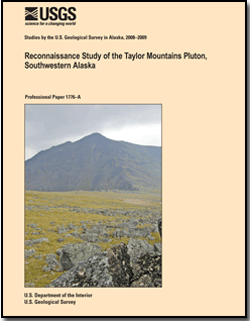U.S. Geological Survey Professional Paper 1776–B
ABSTRACT
The Cannery Formation consists of green, red, and gray ribbon chert, siliceous siltstone, graywacke-chert turbidites, and volcaniclastic sandstone. Because it contains early Permian fossils at and near its type area in Cannery Cove, on Admiralty Island in southeastern Alaska, the formation was originally defined as a Permian stratigraphic unit. Similar rocks exposed in Windfall Harbor on Admiralty Island contain early Permian bryozoans and brachiopods, as well as Mississippian through Permian radiolarians. Black and green bedded chert with subordinate lenses of limestone, basalt, and graywacke near Kake on Kupreanof Island was initially correlated with the Cannery Formation on the basis of similar lithology but was later determined to contain Late Devonian conodonts. Permian conglomerate in Keku Strait contains chert cobbles inferred to be derived from the Cannery Formation that yielded Devonian and Mississippian radiolarians. On the basis of fossils recovered from a limestone lens near Kake and chert cobbles in the Keku Strait area, the age of the Cannery Formation was revised to Devonian and Mississippian, but this revision excludes rocks in the type locality, in addition to excluding bedded chert on Kupreanof Island east of Kake that contains radiolarians of Late Pennsylvanian and early Permian age. The black chert near Kake that yielded Late Devonian conodonts is nearly contemporaneous with black chert interbedded with limestone that also contains Late Devonian conodonts in the Saginaw Bay Formation on Kuiu Island. The chert cobbles in the conglomerate in Keku Strait may be derived from either the Cannery Formation or the Saginaw Bay Formation and need not restrict the age of the Cannery Formation, regardless of their source. The minimum age of the Cannery Formation on both Admiralty Island and Kupreanof Island is constrained by the stratigraphically overlying fossiliferous Pybus Formation, of late early and early late Permian age. Because bedded radiolarian cherts on both Admiralty and Kupreanof Islands contain radiolarians as young as Permian, the age of the Cannery Formation is herein extended to Late Devonian through early Permian, to include the early Permian rocks exposed in its type locality. The Cannery Formation is folded and faulted, and its stratigraphic thickness is unknown but inferred to be several hundred meters. The Cannery Formation represents an extended period of marine deposition in moderately deep water, with slow rates of deposition and limited clastic input during Devonian through Pennsylvanian time and increasing argillaceous, volcaniclastic, and bioclastic input during the Permian. The Cannery Formation comprises upper Paleozoic rocks in the Alexander terrane of southeastern Alaska. In the pre-Permian upper Paleozoic, the tectonic setting of the Alexander terrane consisted of two or more evolved oceanic arcs. The lower Permian section is represented by a distinctive suite of rocks in the Alexander terrane, which includes sedimentary and volcanic rocks containing early Permian fossils, metamorphosed rocks with early Permian cooling ages, and intrusive rocks with early Permian cooling ages, that form discrete northwest-trending belts. After restoration of 180 km of dextral displacement of the Chilkat-Chichagof block on the Chatham Strait Fault, these belts consist, from northeast to southwest, of (1) bedded chert, siliceous argillite, volcaniclastic turbidites, pillow basalt, and limestone of the Cannery Formation and the Porcupine Slate of Gilbert and others (1987); (2) greenschist-facies Paleozoic metasedimentary and metavolcanic rocks that have Permian cooling ages; (3) silty limestone and calcareous argillite interbedded with pillow basalt and volcaniclastic rocks of the Halleck Formation and the William Henry Bay area; and (4) intermediate-composition and syenitic plutons. These belts correspond to components of an accretionary complex, contemporary metamorphic rocks, forearc-basin deposits, and the roots of a volcanic arc, respectively. The similar early Permian sedimentary, metamorphic, and igneous ages are inferred to represent an arc complex that resulted from juxtaposition of a structural lower plate consisting of metamorphosed Paleozoic arc rocks of the Alexander terrane exposed on Admiralty Island, and a structural upper plate consisting of stratigraphically distinct, unmetamorphosed Paleozoic arc rocks representing another component of the Alexander terrane exposed on Chichagof, Kuiu, and Prince of Wales Islands. The Cannery Formation is associated with the lower-plate package. A volcanic arc with magmatic ages ranging from 293 to 278 Ma formed during subduction of the basin between these two (or more) components of the Alexander terrane in southeastern Alaska. Metamorphic-mineral-cooling ages ranging from 273 to 260 Ma are interpreted to date an early Permian orogenic event. Both the early Permian lower- and upper-plate rocks are unconformably overlain by late early and early late Permian limestone, dolostone, and conglomerate of the Pybus Formation that provide a minimum age for this collision. |
For additional information contact: This report is presented in Portable Document Format (PDF); the latest version of Adobe Reader or similar software is required to view it. Download the latest version of Adobe Reader, free of charge. |
Karl, S.M., Layer, P.W., Harris, A.G., Haeussler, P.J., and Murchey, B.L., 2010, The Cannery Formation--Devonian to Early Permian arc-marginal deposits within the Alexander Terrane, Southeastern Alaska, in Dumoulin, J.A., and Galloway, J.P., eds., Studies by the U.S. Geological Survey in Alaska, 2008-2009: U.S. Geological Survey Professional Paper 1776-B, 45 p.
Abstract
Introduction
Cannery Formation
Correlative Occurrences of the Cannery Formation on Admiralty Island
Distinguishing Features of the Cannery Formation in the Type Area
Rocks Assigned to the Cannery Formation on Kupreanof and Zarembo Islands
Devonian Chert-Bearing Lithostratigraphic Units in the Alexander Terrane
Mississippian Chert-Bearing Lithostratigraphic Units in the Alexander Terrane
Pennsylvanian Lithostratigraphic Units in the Alexander Terrane
Permian Lithostratigraphic Units in the Alexander Terrane
Discussion
Implications of Early Permian Sedimentary Facies in the Alexander Terrane
Early Permian Metamorphic Rocks
Early Permian Intrusive Rocks
Summary and Conclusions
Acknowledgments
References Cited
Appendix—Argon analytical data for Permian metamorphic and igneous rocks in the Alexander terrane, southeastern Alaska